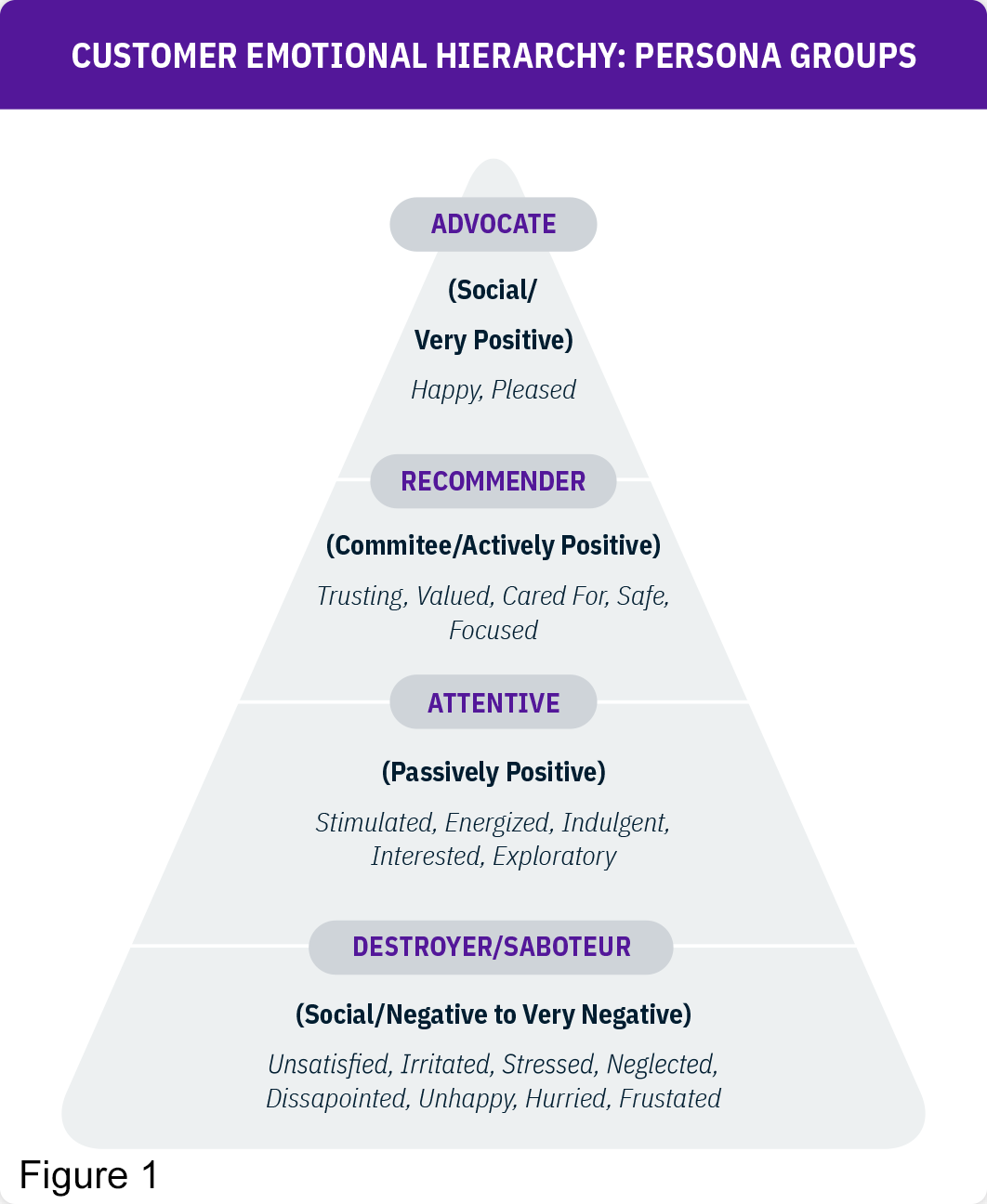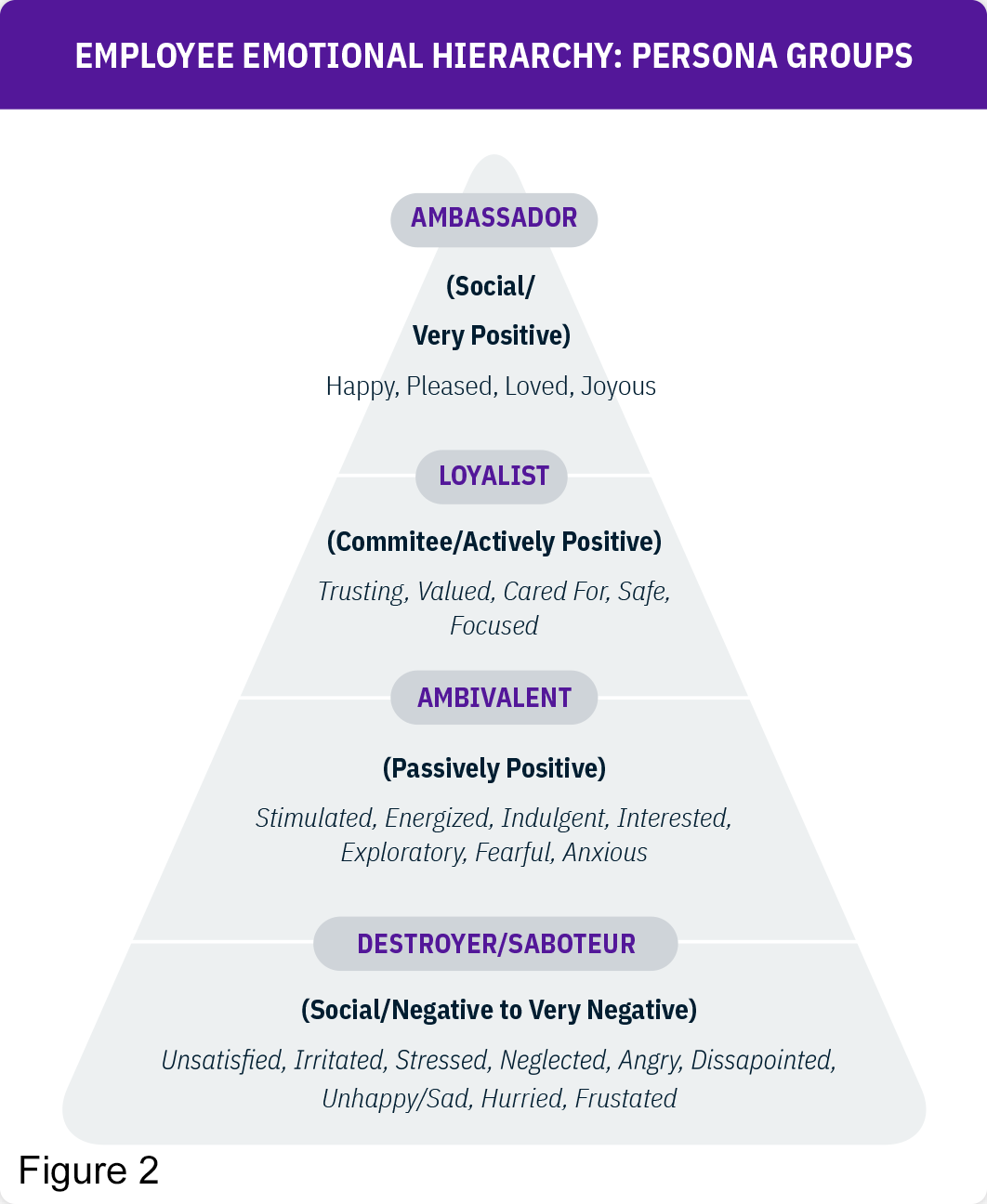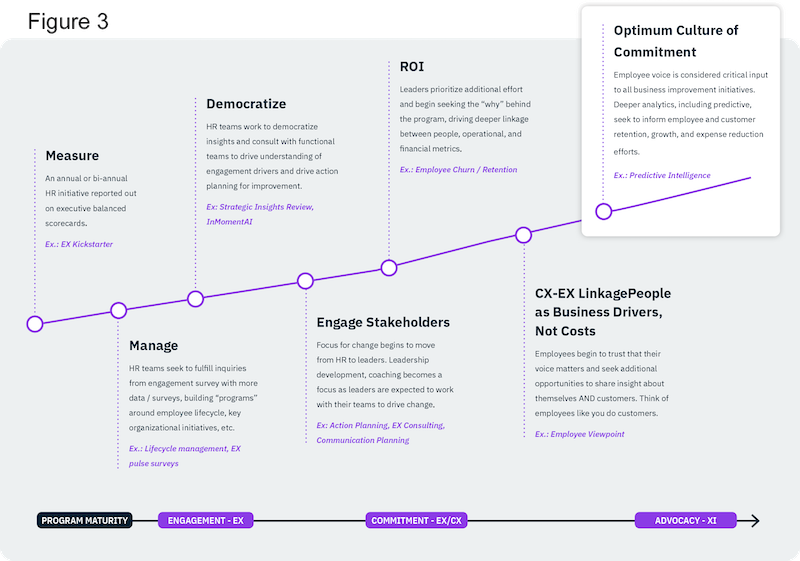Employee Advocacy: Improving Experiences for Employees and Customers

This article was originally posted on Quirk’s Media.
Every successful business outcome benefits from having a reliable, flexible, actionable and amply proven template and improvement guide. This is as true for employee experience (EX) as customer experience (CX).
There is a clear path to greater, more progressive employee experience, insights and greater stakeholder centricity for any organization, and it begins with understanding the concept of experience improvement (XI) as it proceeds and matures.
The most basic definition of employee experience often has to do with overall happiness on the job (or what is generally understood as employee satisfaction). Subsequent stages in EX maturity build upon that first step. Exploring that progression, and how it will lead to experience improvement for everyone in your organization’s universe, is the focus of this discussion.
Employee Satisfaction: Providing a Little More Than the Basics
Employee satisfaction typically encompasses basic job functions like compensation, workload, flexibility, teamwork, resource availability and so forth. It’s built on the basic premise that if employees are happy, they will be productive and remain with their employer. Satisfied employees, then, are generally not aspirational and remain positive if things stay pretty much the same. Much like customer satisfaction, employee satisfaction is largely attitudinal and tactical.
A major challenge with employee satisfaction, though, was identified some time ago. Companies want to keep employees happy and reduce turnover, of course, but it was found that programs and strategies that support improved satisfaction can often result in demoralized staff – especially among employees who either want to perform at higher levels or are unmotivated to contribute more.
Even consultants and professional HR associations like the Society for Human Resource Management have determined that even high-level satisfaction doesn’t necessarily mean closer connection to the employer or greater employee performance.
Here’s a brief example of what can occur through satisfaction-based initiatives, irrespective of intentions. A large national financial services company, concerned that it was experiencing over 30% turnover among new employees, decided to give them a 13% bonus. Those employees who were “satisfied” happily took the additional money, but the result was no discernible decrease in churn.
Employee Engagement: Doing What (Almost) Everybody Else Does
The predominant EX construct that most organizations follow these days is, at its core, to consider employees as necessary costs of doing business. The overall objective of this construct is to optimize employees’ overall fit, utility and productivity within the enterprise. This construct is engagement, which also seeks to quantify emotional and rational job satisfaction (as well as motivation to think, feel, and act). The principal intents of employee engagement, then, are to identify:
- What originally drew individuals to the company.
- What keeps them there.
- What they see as their jobs and how involved they are in them.
- How aligned they are with the company’s overall business goals and culture.
Engagement, however, represents a mix of loosely related concepts and ideas rather than a single, objectively defined term. As a result, it only marginally impacts customer experience and downstream behavior. In 2006, The Conference Board published “Employee Engagement: A Review of Current Research and Its Implications.” According to findings in this report, a total of 12 major studies on employee engagement had been published over the prior four years by top research firms. Each of the studies used different definitions and, collectively, came up with 26 key drivers of engagement. For example, some of the studies emphasized underlying cognitive issues, while others addressed underlying emotional issues. What is absent from these drivers, though, is a focus on how employee behavior connects to, and drives, customer experience. And, though these findings from The Conference Board’s research are, as of this writing, close to 20 years old, the concept of engagement still puts very little emphasis on employees’ role(s) in customer focus and value delivery. In other words, though many companies might infer that happy employees equal happy customers, that relationship isn’t necessarily real or causal.
Further compromising the enterprise value and actionability of engagement is the fundamental issue of measurement. Again, there has never been a reliably clear and consistent definition of employee engagement on which to base performance since the term was first coined by an academic almost 30 years ago. Combine that with the current job market landscape, and it’s clear that employee engagement can no longer be considered a sufficient behavioral standard or organizational goal.
Employee Commitment: Joining the Ranks of the Advanced and Progressive
Employee commitment represents that which most directly shapes and creates the full (and current) EX landscape. It considers employees actively contributing stakeholders who are connected to company culture, derive fulfillment and purpose from their work, and create value for customers. Fundamentally, the concept of commitment recognizes and leverages the employees and their behavior as highly valued enterprise assets and contributions to business outcomes.
Essentially, commitment draws on key elements of both behavioral science and behavioral economics – emphasizing an employee’s emotional connection to the culture, goals, practices and customers of the enterprise – as critical operating resources. Employees have become center stage in optimizing customer behavior and perceived personal benefit in this stage, and have three key traits:
- Commitment to the organization itself, its purpose and its culture.
- Commitment to the organization’s value proposition, its products and its services.
- Commitment to the organization’s customers and fellow employees.
The HR objectives of staff fit, alignment and productivity emphasized in employee satisfaction and engagement are also important in employee commitment; however, this stage of the
employee experience maturity journey recognizes the extent to which employees are in direct and indirect contact with, and providing benefit for, customers. Employees should be enthusiastic and actively supportive representatives of the brand. If, today, employee satisfaction and engagement are not designed to meet this critical objective of the customer experience, then customer-perceived value and customer experience will almost assuredly be impacted.
Employee commitment behavior (and the culture, processes and programs that support it) produce consistently stronger business outcomes (lower staff turnover, more effective experiences for customers, greater loyalty behavior, etc.) in both hard- and soft-cost terms. This more progressive approach to EX also enables companies to directly link, and intersect, employee behavior with customer behavior, making it more powerful than either satisfaction or engagement in creating brand equity.
But there’s even more for ambitious, stakeholder-centric organizations and employees to attain here, and that’s the last, and ultimate, stage of our experience improvement journey: employee advocacy.
Employee Advocacy: Becoming One of the World’s Best
The select brands and organizations that have implemented employee advocacy and its correlating outcomes use stakeholder value creation as the central flow point for operations, processes and culture. Emotional foundations, experience memories and how employees communicate them play a much greater role in employee behavior here (as almost defacto personas). This can be viewed in Figure 1 and Figure 2, which identify levels of both customer and employee value.


Organizations can use employee advocacy to identify the drivers behind employees’ emotional and rational commitment to both their own experience and that of customers. In some instances, though, brands and groups will emphasize social media, image and other related factors as vital facets of employee responsibility. Such factors certainly have their value, of course, but understanding them doesn’t automatically correlate to meaningful experience improvement.
The advocacy concept optimizes employee commitment to the organization, its goals, its value proposition and its customers. Recognition has become especially pronounced in recent years, at least in part due the upheaval produced by the COVID-19 pandemic and subsequent Great Resignation. This, and the impact on employee dynamics, has incentivized many brands to finally invest substantially in a previously underfunded (or unfunded) myriad of employee support resources.
Additionally, advocacy creates a state in which every employee is tasked with delivering customer value as part of not just his/her job description, but as part of their broader role within the enterprise.
Customer value is delivered irrespective of employee location, function or level. In short, everyone from frontline teams to CEOs must understand how their role affects customer experience and remember that it does so regardless of how far they are from the front lines.
Summarizing the Stages, and Trajectory, of Experience Improvement
Regardless of which of stage your organization currently resides in its journey to experience improvement, it’s imperative to regularly assess both goals and priorities, understand what each of these steps has to offer and then work toward a culture of employee commitment and advocacy. A combination of recent talent landscape dynamic events and extensive research has cemented the notion that merely satisfying your employees is insufficient for retaining them or making them feel valued (let alone improving employee or customer experience).
Figure 3 shows a guide that organizations can follow as they pursue employee experience improvement.

By adopting this more progressive and outcomes-oriented set of approaches, organizations can create commitment within their employees, adopt an advanced culture of stakeholder experience centricity and continuously achieve experience improvement for themselves and their customers. The benefits, and the human connections underlying them, are immense.



